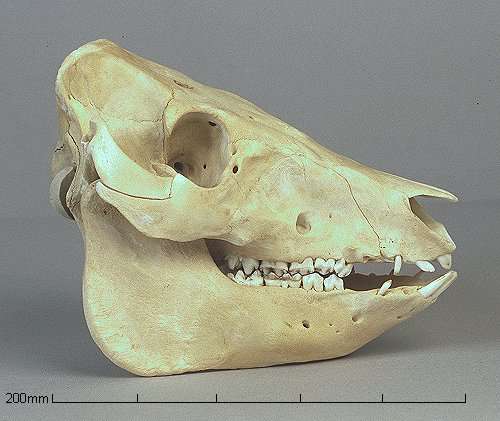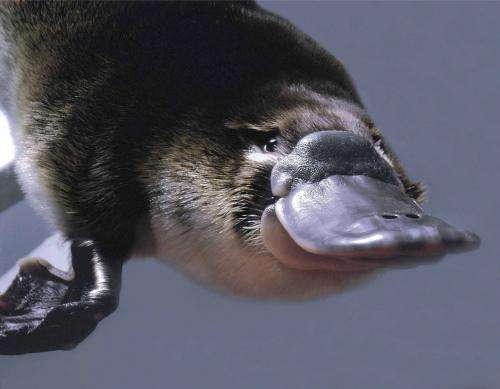July 25, 2013 report
Human hybrids: a closer look at the theory and evidence

There was considerable fallout, both positive and negative, from our first story covering the radical pig-chimp hybrid theory put forth by Dr. Eugene McCarthy, a geneticist who's proposing that humans first arose from an ancient hybrid cross between pigs and chimpanzees. Despite the large number of comments, here at Phys.org, on macroevolution.net, and on several other discussion forums, little in the way of a scientific consensus has emerged. By and large, those coming out against the theory had surprisingly little science to offer in their sometimes personal attacks against McCarthy.
As any skilled listener might observe, the most important thing in communication is not always hearing what is said, but rather, hearing what isn't said. One thing we have not heard here is objection from those writer-scientists who have any kind of public reputation in the evolutionary sciences. I don't think that is because they didn't hear about the story. Talk show host Jimmy Kimmel found the article, or at least parts of it, to be rather revealing, and he used segments from it on his show. Commenters on the O'Reilly Factor also called in asking for his opinion on the story. The reason for the silence from above, so to speak, is that they have nothing to gain in being right, but much to lose when any statement they might offer is picked apart by someone with a little more conceptual fluidity, and who has substantial research vested in the theory.
As many critics noted, the advancement of scientific knowledge does not require disproving every radical theory that comes along. Lots of incorrect theories exist that cannot, for all practical purposes, be formally disproven. It seems, however, that decent arguments against the hybrid origins theory are surprisingly hard to find, and moreover, the established elders of the field, well, they know it.
We decided it would be worthwhile to take a closer look at the objections that were most commonly offered against the hybrid hypothesis. Chief among them was that the chromosome differences here are just too large to support a viable hybrid. One of the previous examples we gave, the zedonk (zebra parent, 2n=44, donkey parent, 2n=62), can and does result in female hybrid offspring that have been reported to produce offspring in backcrosses. The same is true for the geep (sheep, 2n=54, and goat 2n=60). While the reduction in fertility associated with large differences of this sort is often severe, the existence of fertile hybrids, particularly in backcrosses, invalidates this objection.

Another argument was that the morphological distance, or genetic differences besides chromosome number, are just too great. Most of us are familiar with the platypus. A paper published in Nature a few years ago demonstrated that the platypus genome contains both bird and mammal chromosomes, and therefore that the vastly different bird and mammal sex chromosome systems have been successfully bridged by this creature. This example is not offered as any kind of proof. But it does suggest that sometime, long ago, a cross occurred that would have been even more distant than that between a chimpanzee and a pig – one between a otter-like mammal and a duck-like bird. And if such was the case, the hybrids from the cross must have been able to produce offspring (otherwise they would have died out, and the platypus would not exist today).
The objection that mating between such different animals is just too strange has been addressed at length on McCarthy's website. Ample counterexamples have been given there and elsewhere, including the evidence for matings, without issue, between such strange pairings as a buck rabbit with female cat (or even with a domestic hen), or a dog with a monkey, or with a swan goose. In general, as McCarthy points out, it has long been known that many organisms, as adults, prefer to mate with whatever animal they are exposed to at the critical early stage in their lives when sexual imprinting occurs.
He also notes that it is not as if his hypothesis that humans are pig-chimp hybrids has not been tested. Under the alternative hypothesis (humans are not pig-chimp hybrids), the assumption is that humans and chimpanzees are equally distant from pigs. You would therefore expect chimp traits not seen in humans to be present in pigs at about the same rate as are human traits not found in chimps. However, when he searched the literature for traits that distinguish humans and chimps, and compiled a lengthy list of such traits, he found that it was always humans who were similar to pigs with respect to these traits. This finding is inconsistent with the possibility that humans are not pig-chimp hybrids, that is, it rejects that hypothesis.
Also raised was the argument that pigs and humans might have converged anatomically as a result of longstanding animal husbandry, not limited to but perhaps including genes carried over by retroviruses. If that is, in fact, a general mechanism that operates behind the scenes, then we might justifiably ask—why don't a lot of the traits that distinguish us from primates connect us with dogs, with whom we have obviously lived, at close quarters, since prehistoric times? Why is it only pigs?
One objection which seems to have really stretched the genetic exclusion argument was an appeal to junk DNA as a mechanism that can prevent two species from reproducing. The reference was to a paper in PLoS Biology which revealed interesting phenomena occurring in Drosophila (fruit flies) that can prevent embryos from developing. The study points to faster mutation rates found for noncoding DNA, and outlines a mechanism where mutation in a segment on the X chromosome of the father prevents proper separation of the whole chromosome. Clearly, a unique situation in this particular species, however interesting, does not invalidate the documented existence of successful hybrids produced in thousands of other species crosses.
In moving forward, we hope to see more discussion on this issue from both sides of the argument. Nothing is preventing anyone from taking a closer look at the genetic picture. In fact, doing so has never been easier. Sites like eEnsembl let you "browse a genome" with unprecedented ease. Sequence data, or genome organization can be curated to support both observation and idea, as it can also be done to oppose the same. For the matter at hand, we might expect each side to continue to accuse the other of cherry-picking their arguments. Eventually though, sufficient data will fall from the collisions between example-fed discussion and informed search to deliver an elevated consensus. One particular approach recommended McCarthy is in silico chromosome painting of the human genome with random pig and chimp sequences in an effort to find hotspots of similarity to pig.
Another possibility that McCarthy does not recommend, but which several scientists have suggested to him, is producing an actual hybrid. He objects to this approach, not on scientific, but humanitarian grounds. After all, he says, such an experiment might result in an intelligent but non-human creature, much more piglike than any human being, who would have no happy place in our world. He in fact includes such a hybrid, an F1 female, as one of the major characters in The Department, his kindle book satire of academic life. In it he observes, "I hope never to meet her in the flesh." You can see McCarthy address some of the issues raised above in greater depth in a podcast that has just been released.
More information: www.macroevolution.net/
Journal information: Nature , PLoS Biology
© 2013 Phys.org



















